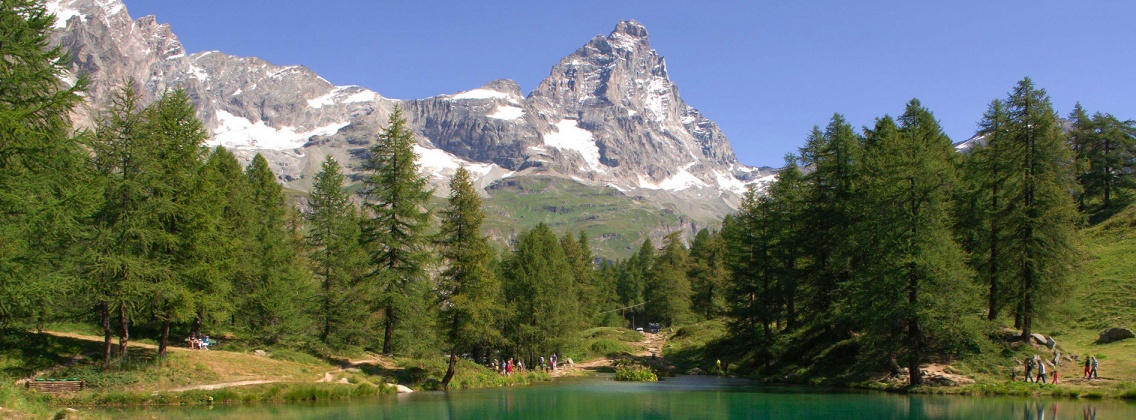
Aosta Valley
Visit Aosta Valley, majestic peaks and valleys of great charm
Territory of Aosta Valley
Valle d'Aosta is the smallest Italian region and also the least populated, with a territory completely mountainous, it develops in the middle of the Alps. The region is surrounded by the four highest mountain ranges in Italy: Mont Blanc, Matterhorn, Monte Rosa and Gran Paradiso.
The region borders Switzerland to the north, France to the west, Piedmont to the south and east.
Useful information about Aosta Valley
The Aosta Valley is a region in northern Italy, with Aosta as its capital. The only province is Aosta which coincides with the region which in turn hosts 74 municipalities.
The official languages are two: Italian and French, in fact Valle d'Aosta is a member of the International Association of Francophone Regions.

Looking for tips for your next trip? Ask Monna Lisa.

Discover the Italian Ambassador of Excellence in this region
Places and tours of Aosta Valley
Aosta, the regional capital situated in the middle of important mountains, boasts many remains of Roman origin: the theatre, the amphitheatre, the bridge. Not to be missed are various castles scattered throughout the region. The best known: Castle of Fénis.
In the Valle d'Aosta the protagonist is nature, an obvious example is the Gran Paradiso National Park, one of the most important Italian national parks, as well as the oldest. Courmayeur at the foot of Mont Blanc is a very popular destination during the winter months for its ski slopes.

Tours and Experiences in Valle d’Aosta
Aosta Valley Region
The Aosta Valley is an Italian region with special status, it is located to the northwest and is the smallest, least populated and with the least population density of all Italy. It is also the only one to have a single province, Aosta.
The territory is completely mountainous and there are the highest peaks in Italy, which are in some cases also the highest in Europe: Mont Blanc (4,809 meters), Monte Rosa (4,634 m. of which the highest peak, Punta Dufour, is located in Switzerland in the municipality of Zermatt), the Matterhorn (4,478 m.) and the Gran Paradiso (4,061 m.). From a geological point of view, the Valle d'Aosta is a meeting point between the European plate and the African plate, a phenomenon that gave rise to the mountain range of the Alps.
This border position has made it a land of passage throughout history: on its territory there are many passes that connect it to France, Switzerland and other neighboring regions or connect two valleys in the same region. The most important from a geographical and historical point of view are certainly the Piccolo San Bernardo towards Savoy (France) and the Gran San Bernardo towards Valais (Switzerland).
The main valley is of glacial origin and gives its name to the region: it consists of the catchment area of the Dora Baltea, the most important river, which collects the numerous tributaries that form the remaining secondary lateral valleys. It rises from the Brenva glacier in Val Veny, at the foot of Mont Blanc and runs through the valley from north-west to south-east for 160 kilometers to Crescentino in Piedmont, where it flows into the Po river.
The lateral valleys depart from both the right and the left bank of the Dora Baltea and their rivers are all torrential.
The natural lakes of Val d'Aosta are of glacial origin, they are all modest in size and are generally between 2,000 and 2,700 meters above sea level. The artificial reservoirs formed by the construction of dams for the production of electricity have greater flow, the main are
Lake Place-Moulin in Bionaz, Lake Beauregard in Valgrisenche and Lake Cignana in Valtournenche.
A part of the Valdostan area, about 4%, is covered by glaciers that unfortunately are retreating due to climate change: there are about 200, but the number is destined to decrease drastically over a few decades.
From the administrative point of view, the Aosta Valley is one of the 5 autonomous regions of Italy: the capital is Aosta, the only town that can be considered a real city, even if of rather modest size, with a population of about 33 thousand inhabitants.
The territory is divided into 74 municipalities, none of which excluding Aosta exceeds 5000 inhabitants. Among the most populated are Sarre, Saint-Vincent and Châtillon.
The languages spoken are Italian and French: in some municipalities of the Lys valley, at the foot of Monte Rosa, the "titschu" survives. It is a German origin language: here in fact the territory was once colonized by Valais Walser populations. The "patois valdôtain" is known and spoken by most of the population and is considered a dialect variant of the Francoprovençal language.
We can start from the language to trace a historical identity of the Aosta Valley: The "patois valdôtain" in fact is clearly a Francophone language and the region is officially bilingual. Originally Latin was spoken in the region, Aosta in fact in 25 BC was conquered by the Romans who incorporated the pre-existing Celtic populations.
In the centuries following the fall of the Western Roman Empire, there was a succession of kingdoms and cultures: starting from the rule of Odoacer and then passing to the Ostrogoths with King Theodoric, to the Praetorian Prefecture of Italy following the Gothic War, finally conquered by the Lombards in 568. Later in 575 it was conquered by the Franks, but following the conquest of the Lombard kingdom by Charlemagne in 774 also Aosta passed to the Carolingian Empire.
From 972 to 1032 Aosta was assigned to Conrad III of Burgundy, and political and commercial relations with France were strengthened: it was from this period that the Francoprovençal dialects began to spread in the Aosta Valley.
In 1032 it became a county of Umberto Biancamano, a member of the Savoy dynasty, who in 1302 transformed it into a duchy, granting it more and more autonomy. But the perception of its diversity was already rooted for a long time in the culture of the Aosta Valley and in 1032 the House of Savoy, granted the first franchises. At the end of the twelfth century a "special statute" was claimed to regulate relations between the rulers and the people. Thus was born in 1191 the "Charte des franchises" that granted a kind of autonomy to the Aosta Valley.
In the Middle Ages the feudal nobility gradually gained more and more power in the region: being a land of passage required to travel across the Alps through the passes, owning land in these areas meant being able to collect tolls and acquire wealth and power. The morphological characteristics of the region lent themselves to the construction of fortresses and castles and in this period the nobles built a large number of them, often rehashing pre-existing structures. This architectural and cultural heritage has fortunately been handed down to the present day: the Aosta Valley is also called “Valle dei Castelli”, Castles' Valley.
In 1430 the Valdostan nobility rebelled when Duke Amedeo VIII tried to impose the "Statuta Sabaudiae", the legislation already in force in the territories of the Savoy.
In 1536, Francis I of France invaded the Savoy territories without going into the Aosta Valley: the following year a treaty of neutrality was signed between the Aosta Valley and France.
Meanwhile, the Valdostans did not stop strengthening their autonomy with the "Conseil des Commis", which for about two centuries ruled the local government assuming all the powers and making the Aosta Valley a kind of independent state, where justice was administered by the "Cour des Connaissances".
In 1630 the plague spread among the population decimating it. Two out of three inhabitants were victims of this terrible epidemic and to replenish the valley by adding new labor force in the fields and in the workshops, the immigration of settlers from Switzerland, Savoy and Upper Piedmont was encouraged,and the new inhabitants integrated into the social fabric with their different cultures. In 1691 and between 1704 and 1706, the Aosta Valley was occupied twice by French troops, who renewed their cultural influence on the region.
Also the Catholic Church, thanks to the presence of many monasteries and religious orders exerted a strong influence on the population in its rebellion against the Savoy. In 1764 the "Royale Délégation" was established and the work of this delegation gave rise to the general land registry of the Aosta Valley. Nine years later the Communes and the private ones had the concession to buy the right of exemption from the feudal canons paid to the lords: the feudalism definitively faded and a new form of self-government of the Valdostans was born. In 1770 the "Royales Constitutions" replaced the "Coutumier" and the ancient legislation that was applied in the Aosta Valley was definitively abolished.
On the threshold of the French Revolution that would have upset the geopolitical order of Europe, Savoy reformism came to cancel privileges and local institutions. At the "Conseil des Commis" the powers and the number of members were progressively reduced.
Between 1789 and 1799 the French Revolution broke out. The Aosta Valley was occupied by the French revolutionary troops in 1794 and annexed to France in 1796 and then entered the Dora department in 1802. The diocese of Aosta was suppressed in 1803 (to be reconstituted after the fall of Napoleon in 1817).
The Aosta Valley returned to the Duchy of Savoy in 1814, becoming part of the Kingdom of Sardinia in 1847. The first free elections took place in 1848 in a period of strong social tensions.
After the cession of Savoy to France in 1860 and the Unification of Italy in 1861, the Aosta Valley tried to maintain its own linguistic and cultural traditions and specificities, despite the fact that the Italian language was imposed on each region as official.
From the 1880s the population increase pushed to a strong emigration to Switzerland, France and later, until the 1920s, also to the United States of America.
Fascism overturned every goal achieved in previous centuries trying to italianize the Aosta Valley: village schools (écoles de hameau) were abolished and the exclusive use of the Italian language in offices was imposed. The teaching of the French language was suppressed, French newspapers were closed, the use of French in the press was banned, and Valdostan place names were italianized with ridicolous phonetic results.
He also gave the Valle d'Aosta the status of province, separating it from the district of the province of Turin, but also including the Canavese whose population was Italian-speaking.
A secret society, the Ligue valdôtaine, was created to defend the use of the French language and the Valdostan identity. At the same time an intense partisan activity began to spread in the valleys. The Valdostan resistance resulted in the declaration of Chivasso, drawn up together with representatives of the other Francoprovençal Alpine valleys, for the defense of the identity of the Alpine communities.
In 1945, during the Second World War, the provinces of Aosta and Imperia were occupied by France, with the declared intention of annexing them to its territory. It was American President Harry Truman who ordered General Charles de Gaulle to withdraw, while the Italian government decreed the suppression of the province of Aosta by subordinating it to Turin.
Having become an autonomous constituency in 1946, it was finally granted the Special Statute by the Italian Republic in 1948. From this moment, the status of equality of the Italian and French languages was officially established.
While up to this time the population had survived only of agriculture and pastoralism or thanks to emigration to France or Switzerland, after World War it began the so-called "economic boom" with consequent population growth and increased welfare.
Touristic and industrial development reversed the depopulation trend and increased immigration. Currently, the region has a population of about 120 thousand inhabitants, one of per capita income among the highest in Italy and is one of the most popular touristic destinations.













Ciao! I'm Monna Lisa, your digital travel designer. I'm here to help you plan your perfect trip to Italy.